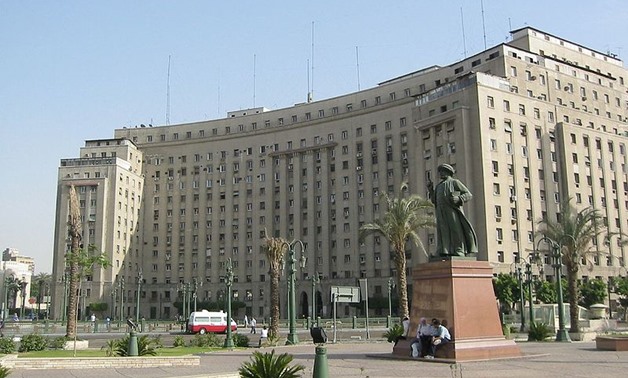
Mogamma al-Tahrier building, Downtown Cairo – One of Egypt’s largest governmental buildings via Wikimedia Commons
CAIRO – 1 September 2018: Tens of governmental facilities worth more than LE 700 billion will likely turn within the coming months into abandoned buildings after relocating to Egypt’s New Administrative Capital as planned by the government.
However, several parliament members have proposed different suggestions to re-use these buildings in a way of which the country can benefit from.
Parliamentarian Mohamed Abdalah Zain Eddin stressed that the government should have a comprehensive plan to re-use these buildings again. “According to preliminary estimates, the value of these buildings could exceed LE 700 billion.” Zain Eddin said. He added that these buildings have a long historical value related to Egypt’s heritage. “We need a clear plan about that.”
MP Yasser Omar, deputy of Planning and Budget Committee, suggested that these ministerial buildings could turn into historical museums; “However the country has to use it economically as much as it can. It could be one of the country’s resources.”
Another MP, Mohamed Abu Hamed suggested that these buildings should be included within the country’s sovereign fund to figure the best method or reusing it again whether through renting, selling or investing in them.
Most of the ministerial and governmental buildings in Egypt are located downtown; however, since the announcement of establishing the country’s new administrative capital, all of the governmental buildings, including the parliament, are expected to be relocated there.
Earlier in August, the Vice President of China State Construction Engineering Corporation (CSCEC) Zheng Xueyuan stressed that all construction works of the New Administrative Capital are scheduled to be complete within three-and-a-half years.
Xueyuan added to Xinhua News Agency that the project aims to provide thousands of jobs and stimulate the Egyptian economy, while the Egyptian government institutions are scheduled to move to the new capital during the second half of 2019. The project reflects the depth of Egyptian-Chinese relations.
“The center will feature a 345-meter of skyscraper, which will be the tallest building in Africa. It will also include 12 shopping malls, 5 residential buildings and 2 hotels,” Xinhua News Agency said.
Wang Xiangming, head of CSCEC, thanked the Prime Minister during his meeting one week ago."I want to assure you that we will implement this project according to our agreement,” he said.
“We will try to implement the two phases in the shortest possible time in the best way to work, and we will provide all the resources of the company to speed the implementation of the project with high quality,” he added.
President Abdel Fatah al-Sisi has laid the first stone of the New Administrative Capital in East Cairo in October 2017. With an area of 170,000 feddans, the new capital will include 20 residential areas expected to accommodate 6.5 million people and a road network 650 km in length. The capital was planned to include an international airport and an electric train to link it with the 10th of Ramadan and El-Salam cities.
It will feature 1,250 mosques and churches, a 5,000-seat conference center, nearly 2,000 schools and colleges, over 600 medical facilities, and a park that is projected to be the world’s largest.
The New Administrative Capital is located in the area between the Cairo-Suez and Cairo-Ain Sokhna roads, east of the regional ring road. This is roughly 60km from the cities of Suez and Ain Sokhna.
The new capital is planned to be a sustainable city, housing the ministries, parliament, Egyptian Media Production City, presidential palaces, and embassies.
Twenty-five public and private construction companies have been mandated to carry out the infrastructure projects and build the residential neighborhoods of the new capital, while the army is only responsible for managing the project.
The company provided about 170,000 jobs in the construction operations and the coming phases of the project will require more workers, stressing that the state treasury does not bear the burden of financing any phase of the project.
Housing prices in Cairo will decline significantly in the coming years because of the rise of supply in the market after completing the construction of the planned 350,000 housing units in the capital.
The New Administrative Capital Company is 51% owned by the armed forces and 49% by the New Urban Communities Authority (NUCA). The paid-up capital of the company amounts to EGP 20bn, including contributions from the armed forces and NUCA, and the authorized capital is EGP 204bn.
Comments
Leave a Comment